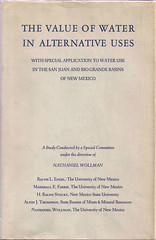 It was pouring rain when I left the office this evening, so I took surface streets rather than the messy freeway. The concrete arroyo by my work was running high as I passed, so I started slowing and watching every time I went over one. They were raging and roiling and doing their best to remind me of a point I often miss living here in the city.
It was pouring rain when I left the office this evening, so I took surface streets rather than the messy freeway. The concrete arroyo by my work was running high as I passed, so I started slowing and watching every time I went over one. They were raging and roiling and doing their best to remind me of a point I often miss living here in the city.
I was talking to a pal the other day who’d been looking at old aerial photographs of the city. She was describing the mental exercise of mapping the old landscape to the new. The included picture, courtesy of the University of New Mexico’s Earth Data Analysis Center, is worth a click through if you’re from Albuquerque and want to understand what she was talking about. I don’t know when it was taken (my guess is the 1930s). Up near the picture’s right-hand corner, right about under the “6”, is where my house is today.
The developed part of the picture is primarily the Rio Grande valley floor, and you can see all the old arroyos cutting their own way down from what is now the city’s eastern heights. Every one of those arroyos is now gone – in fact, the entire area visible in the picture is paved over save a strip along the river. But the water still has to go somewhere, so we’ve substituted a spiderweb of concrete arroyos for the old dirt ones. It’s a way of containing that which cannot be controlled.
Must’ve been something to see the water come down those arroyos back in the day.


 The blogger known as
The blogger known as  What
What